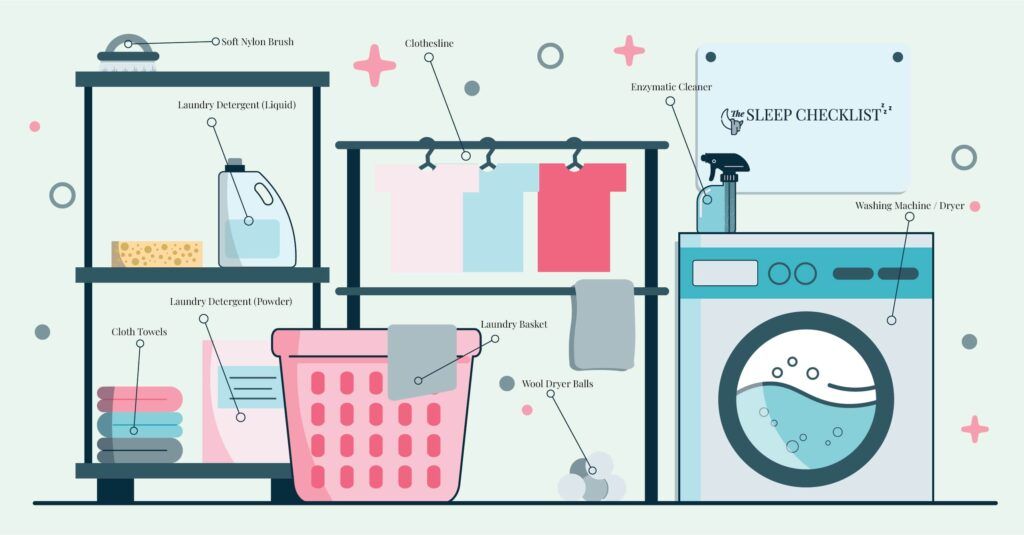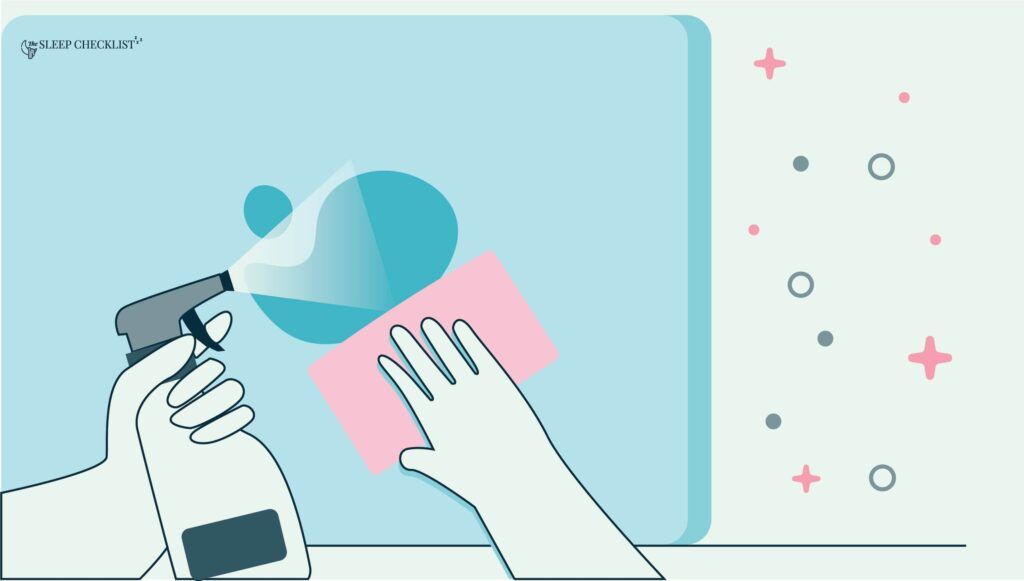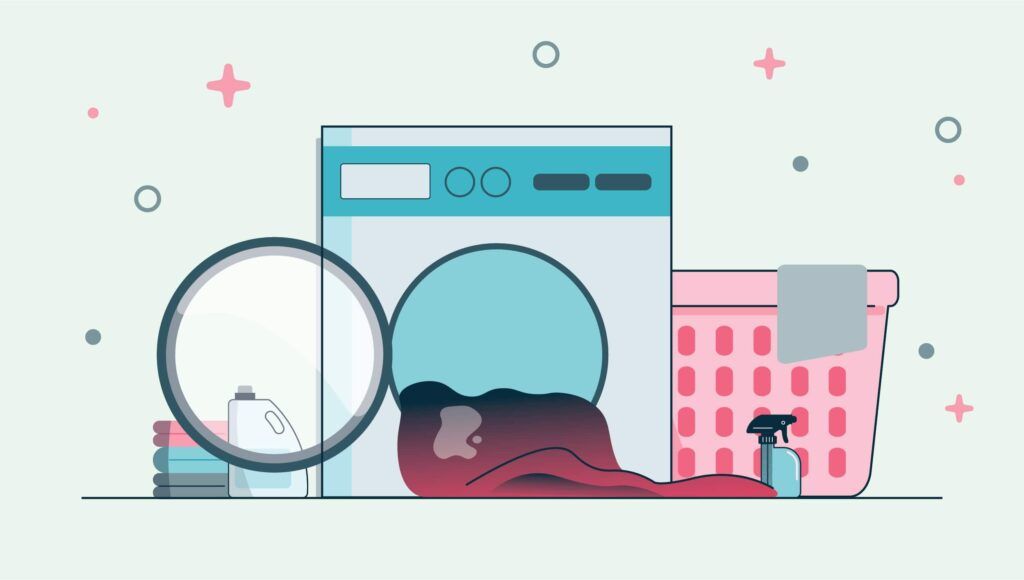Is your mattress protector disgustingly dirty and in need of a wash? If it is, this quick and easy guide using household cleaning products will have it sparkling new in no time.
Mattress protectors can accumulate dirt, sweat, and other allergens over time. And let’s be honest, a dirty protector isn’t exactly guest friendly, right?
Even if you have the best mattress protector on the market, you can’t escape from cleaning them. Especially when your mattress can carry 17,442x more bacteria than a toilet seat!
It pays to know how to properly clean and wash a mattress protector to sleep in a hygienic environment. Let’s get to it.
Equipment & Materials Needed
Before starting your mattress protector cleaning process, you’ll need these materials first. Prep the below items for a smooth cleaning experience:

- Washing Machine
- Dryer or clothesline
- Paper or cloth towels
- Wool dryer balls
- Soft nylon brush
- Laundry detergent
- Enzymatic cleaner
Cleaning Steps
There are two types of cleaning methods you can use.
- The spot-cleaning method is cleaning out only the dirty surfaces of the mattress protector, hence called spot-cleaning.
- The machine wash method is cleaning the entirety of your mattress protector using a washing machine.
instructions for Non-washable mattress protectors

Spot-cleaning works best for mattress protectors that aren’t washable. It’s usually foam-based mattress protectors that aren’t machine washable. But to be sure a mattress protector can be spot-cleaned, make sure to check the label carefully.
Step 1: Remove the Mattress Protector
The first thing to do is to remove the mattress protector from the bed to access the protector.
Remove all your bedding and pull the mattress protector away from the bed.
Step 2: Remove Excess Liquids or Solids
If there are substantial or little amounts of liquid and/or solids, remove them by using a paper or cloth towel.
For liquids, dab the liquid away so the towels can absorb it. For large pieces of dirt, use the cloth and try to pinch or scoop them out.
Step 3: Spray an Enzymatic Cleaner
Spray at the dirty part of the mattress protector generously and let the solution rest for a few minutes.
Step 4: Scrub & Remove Excess Solution
After leaving the enzymatic solution for a few minutes, get a soft-bristled brush and scrub away at the site. Use a paper or cloth towel again to remove the excess solution.
Step 5: Dry the Mattress Protector
Dry, the mattress protector by hanging it outside on a clothesline or by using an electric fan.
Careful not to hang foam-based mattress protectors in the warm sunlight as they can be damaged because of heat.
Optional Step:
You can top your spot-cleaning session off using essential oils to make your bed smell fresh.
To do this, mix a few drops of the oil into a spray bottle with water and mist your mattress. Just remember to fully dry your mattress afterward
Instruction for Machine Washable Protectors

Machine washing works best for natural-based and polyester-based mattress protectors. Although, always read the mattress protector’s care label to double-check that it can be washed.
Step 1: Remove the Mattress Protector
Remove the mattress protector by carefully dismantling all the bedding until you access your mattress protector.
Step 2: Read the Product Care Label
As we mentioned above, mattress protectors have care tags and/or labels that advise how to care for the protector.
Read the labels carefully and make sure not to deviate from the instructions so you can prolong your mattress protector.
Step 3: Prep Your Washing Machine
Prepare your washing machine according to the product care label of the mattress protector.
The most common washing machine settings for mattress protectors are low, normal, bulky cycle wash with the water temperatures between warm and cold.
You may have seen this info when reading the product care label before washing, but have a quick glance again to ensure you set the correct settings.
As for the laundry detergent, your regular liquid laundry detergent will work just fine. But if you have a down mattress protector, you must buy laundry detergent made explicitly for down.
These detergents protect the hydrophobic qualities of the down and feather inside the mattress protector.
Step 4: Dry Using a Dryer, Clothesline, Or a Fan
After the wash cycle, you have two drying options:
- Dry the protector using a dryer. If you use a dryer, make sure to use wool dryer balls (or tennis balls if you don’t have any). These balls provide extra space for the hot air to run through, resulting in a fully dry protector.
- Sun-dry using a clothesline. If you use a clothesline to sun-dry your protector, secure it very well in case there’s a big gust of wind. Standard clothes peg will work well, 4-5 will do the trick.
- Dry using a fan. If you don’t have a functioning dryer and the weather’s awful, you can’t sun-dry, you can opt to dry your mattress protector using a fan instead.
How Often Should I Wash My Mattress Protector?
You should wash your mattress protector once every 2 months to prevent the build-up of dust, debris, allergens, mould, and more. If you’re highly allergic, wash it twice a month to prevent the accumulation of allergens such as dust mites.
Some incidents will require you to act quickly and wash as soon as possible:
- bedwetting
- spilled drinks like milk or wine
- sweat stains and smell
Letting drinks or urine stay will cause an accumulation of bacteria that leads to a foul scent and odour.
We also recommend investing in a hypoallergenic mattress protector that may help if you suffer from allergies. These protectors are made of fabrics that retain fewer indoor particles and therefore give you a cleaner sleeping surface.
Can You Machine-Wash a Foam Mattress Protector?
No, you cannot machine-wash a foam mattress protector. Foam-based mattress protectors such as polyurethane can be damaged during a washing machine’s spin cycle.
Water and polyurethane foam are not a good combination as water destroys the foam’s structural integrity.
Use the spot-cleaning method above.
How Often Should You Replace Your Mattress Protector?
You should replace your mattress protector every 1-2 years. As long as you regularly clean your protector it should last on the upper end of the 2 year range.
However, suppose you already see apparent signs of wear and tear.
Replace your mattress protector as soon as possible since wear and tear is evidence that your protector can no longer protect your bed from stains. Two options that have been tried and tested include:
- Emma Mattress Protector
- Simba Mattress Protector
Can I Wash My Mattress Protector With My Sheets?
Yes, but note that this entirely depends on your washing machine’s size. Chances are, your mattress protector can be too bulky to the point adding in your sheets can strain your washing machine.
It’s better to wash one product at a time if you have a small washing machine.
1 Sources
- Schei MA, Hessen JO, Lund E. House-dust mites and mattresses. Allergy. 2002;57(6):538-542. doi:10.1034/j.1398-9995.2002.23433.x






